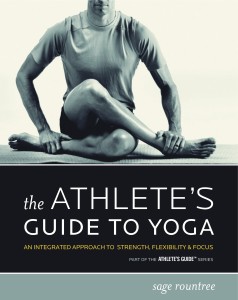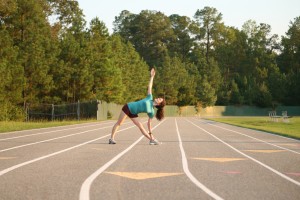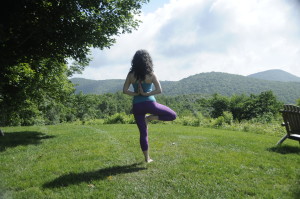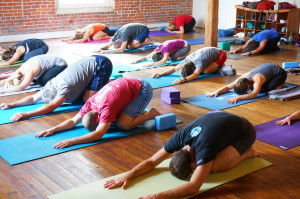I met Sage Rountree at the Kripalu Center for Yoga and Health in Stockbridge, MA. Rountree was there to teach and I was there to study. I had seen a course advertised that I thought you, Active Vermont readers, would like to learn more about, so here goes.
 YOGA FOR ATHLETES
YOGA FOR ATHLETES
The very thought of what is perceived to be yoga is abhorrent to many athletes. For some, the competitive fire is burning so brightly that the idea of taking time away from strenuous training is simply inadmissible. For others, those for whom hours to devote to training are hard to find, exchanging a personal nose-to-the grindstone workout, or better yet, a sufferfest, for sitting in a studio chanting ommmmmm (or whatever) is unthinkable.
But think again.
Athlete: “One who participates in physical exercise or sports, especially in competitive events. One possessing the requisite strength, agility, and endurance for success.” (thefreedictionary.com) Consider the growing fitness industry, the number of individuals from all walks of life, shapes and sizes and the swelling number of entries in 5ks, half-marathons and century rides. Notice your neighbors hiking, playing ice hockey in the winter and softball in the summer, moving away from inactivity and taking on activity. All are athletes.
Yoga: the Sanskirt word means to yoke. Rountree defines yoga as connection. “When you are connected you can get things done. We need to connect body with breath, breathing with intention,” she said.
Athletes who counter strength, endurance and sports-specific skills training with the practice of yoga to address flexibility, core strength, physical and mental balance and breathing, are the ones who live most fully the promise of an active life.
SAGE ROUNTREE 
Rountree, who lives in Chapel Hill, NC but is internationally recognized, is a young and vibrant 44-year old daughter, wife, mother, athlete, writer, speaker, business owner, teacher and oh did I mention competitive athlete?
She has written six books, travels widely and presents often, is a certified triathlon and running coach, a yoga teacher, on the faculty of Kripalu, and specializes in endurance sports. Rountree talks the talk and walks the walk.
Rountree admits that she hated her first yoga class. She struggled with the poses feeling unbalanced and inflexible and resented giving up her aerobics class or time in the weight room for the hour. Later, however, in marathon training with her husband, she tried again and to her surprise realized that her yoga classes supported her running, strengthening her both physically and mentally and making the pursuit of her sport less painful while avoiding injury.
This, she says, is the only way to convince a doubter that yoga is beneficial. If the athlete will just give it a try, improved performance will do the rest. Rountree’s goal is to “help people find the right balance between work and rest for peak performance in sports and in life.”
WORKSHOP NOTES
Yoga for athletes is not athletic yoga. Athletes are usually inflexible, driven, and not good candidates for some of the more gymnastic poses found in some forms of yoga. Athletes need to “leave your ego at the door,” Rountree said, “and be part of the journey from physical to mental and integration. It’s whatever it is that brings you to your mat.”
“Yoga should complement training, not be an extension of it. Our goal is balance for injury prevention and emotional/mental health. The physical intensity of yoga should be in inverse proportion to the physical intensity of training.”
Some use yoga for conditioning. That’s fine. But athletes need more. Athletes need to plan their yoga practice to coincide with their periodized sports training. When it is off-season for a sport, it is time to ramp up the intensity of yoga practice and, conversely, during the competitive season, yoga should be for rehabilitation and recovery.

Yoga at the track; triangle pose before running; photo by Wes Rountree
“Yoga should help maintain flexibility as training gets more intense,” Rountree said. Learning mental and breathing skills helps competitive athletes remain calm even in the face of competitive or training intensity.
In other words, practicing yoga for the athlete is more than physical exercise yet the work results in the ability to use physical strengths more efficiently and effectively. “Avoid trying to win at yoga,” Rountree said. “To stay on the edge and keep pushing is not the way to go. Maintain presence in the face of intensity.”
Focus is important. If, in the midst of heavy training or difficult racing the athlete loses focus, he or she will become scattered and inefficient. Performance will suffer. The ability to maintain focus is one of the things one learns in the practice of yoga.
In my own experience I have found that when I walk, hike, run or ride I keep a good pace when I am focused. When I daydream, I find myself falling behind my companions or competitors. I learned that dharana, one of Patanjali’s eight limbs of yoga, is about focus. At one point in a TT (time trial) last summer, I thought I would have to back down, but then I kept my focus by repeating “ride through it” until I crossed the finish line. At that time I knew little of yoga but this concept rings true.
If you are a runner, you may have been taught to breathe in and out with every 2 or 3 or 4 steps. If you are a swimmer, your ability to coordinate breathing with strokes is imperative. Weight lifters are taught to exhale at the point of greatest exertion while all of us are encouraged to become adept breathing through the nose.
Yoga teaches forms of breathing that include short, explosive breaths as well as breaths with slow, deep inhalations and exhalations. Practicing holding the breath when fully inhaled or exhaled is also significant. Simple awareness is equally valid.
Recently I read of square breathing: inhale for a predetermined number of counts, say four, hold for same number (or four counts), exhale for same, and again hold for the same (or four counts).
Which reminds me of something that I’m sure you have also noted. In our ever-expanding world of teaching, training, learning and integrating disciplines, we find more and more a connection between orthopedics and cardiology in the health professions; physical therapy and personal training in the rehabilitative; and Pilates, core conditioning, functional training and yoga in the athletic. For example, a plank is a plank is a plank whether it comes from your physical therapist, personal trainer or yoga teacher.
POWER POINTS
Add yoga to your daily schedule. (well, almost daily) “When just beginning a sport,” Rountree said, “frequency is most important (enough to create change but not enough to break down). It is better to do yoga 3, 4, 5 days a week for as little as even 10 minutes, than to do one long session per week.”
“Learn to be comfortable with discomfort,” she said. Accept that stress is good for you. There is a fine line between beneficial, productive stress and needless suffering. Discern between a groove and a rut.
An athlete needs enough stress to create change, but not so much as to injure, “work to the edge but do not fall over it,” Rountree said.
Also practice being comfortable with comfort. “Play the bottom edge,” she said. “As an athlete who pushes the upper edge, this is important.”
Balance training helps prevent injury. It’s easy to understand that the body’s balance in space can help prevent acute injuries. Another kind of balance, balance within the body, helps prevent overuse injuries while the balance of stress and rest prevents burnout.

Balance helps prevent injury. Sage Rountree. Photo by Wes Rountree
Yoga leads practice in all forms of balance: strength and flexibility; mobility and stability’ soft tissue and bones’ stress and rest.
THE PRACTICE
In her book, “the Athlete’s Guide to Yoga, an integrated approach to strength, flexibility and focus,” Rountree writes: “… you must practice with the body you have in this moment, not the one you had ten years ago, ten weeks ago, ten days ago, or sometimes even ten minutes ago. At the same time, don’t be complacent. Stretch yourself, physically and mentally. Try challenging poses, but try them with respect and care.”
Set small goals. Begin with a dynamic warm up. Practice balance, core and static stretches after your workout. Practice reclining twists and restorative yoga at any point of your season. Visit the six positions of the spine and four lines of the hips regularly. Honor preemptive rest.
“Just as you plan a season, a training block, or a workout with a sense of its purpose, you’ll want to approach every yoga session with an intention.”
There’s much to be said and Rountree says it directly to us, the athletes, and says it well. I encourage you to explore Rountree’s writings, or go to www.sagerountree.com or facebook.com/sagerountree.
“It’s tough,” Rountree says about taking that first step into the practice of yoga. “It takes faith and patience to get into the softer stuff. Try it and see.”
And her final words of advice: “Relax. Relax so you can go harder in the next race.”

Athletes recover in child pose. Photo by Wes Rountree.
Linda Freeman
